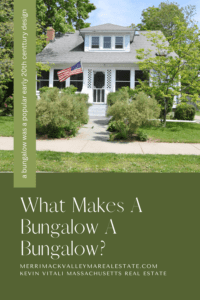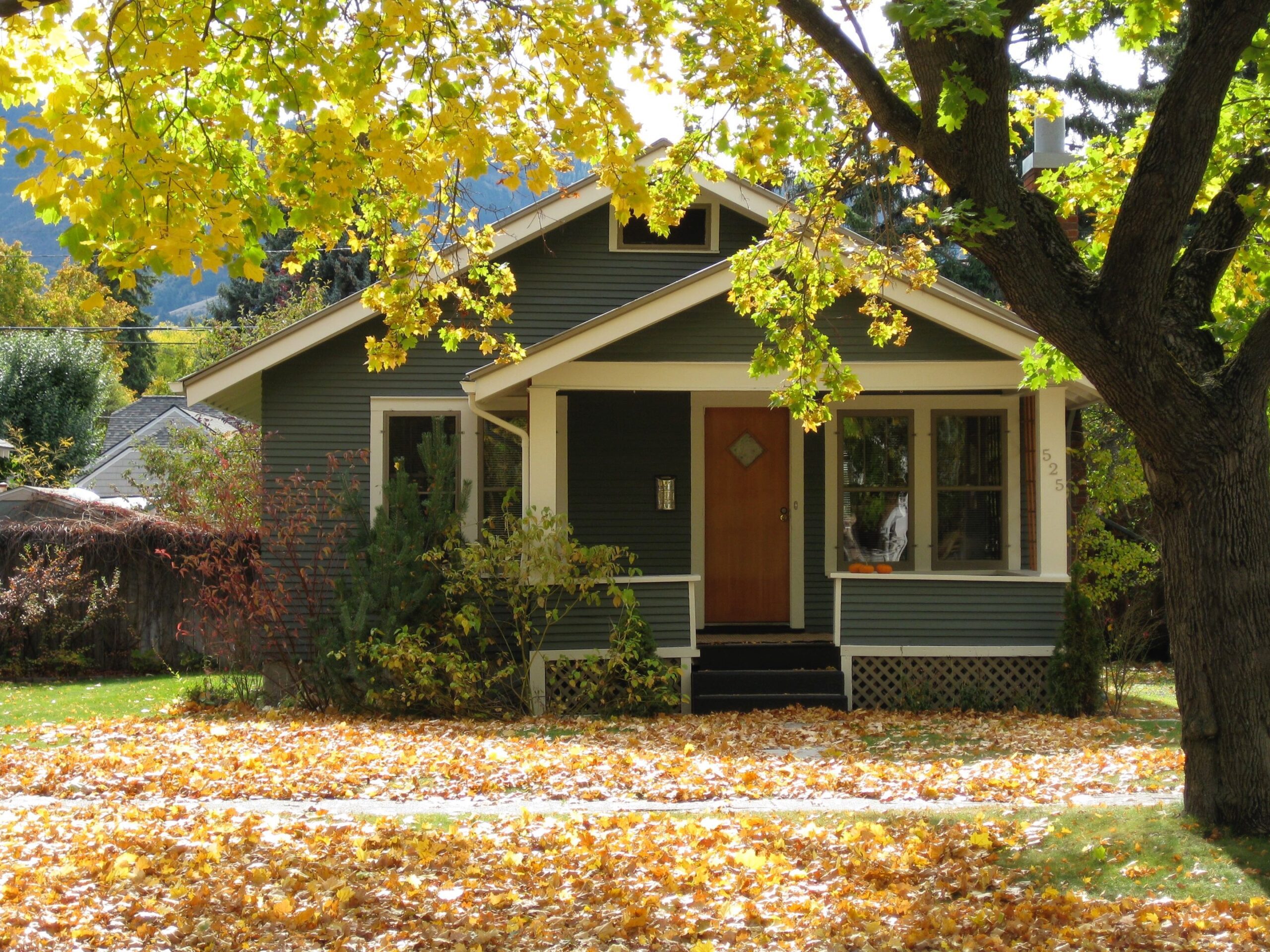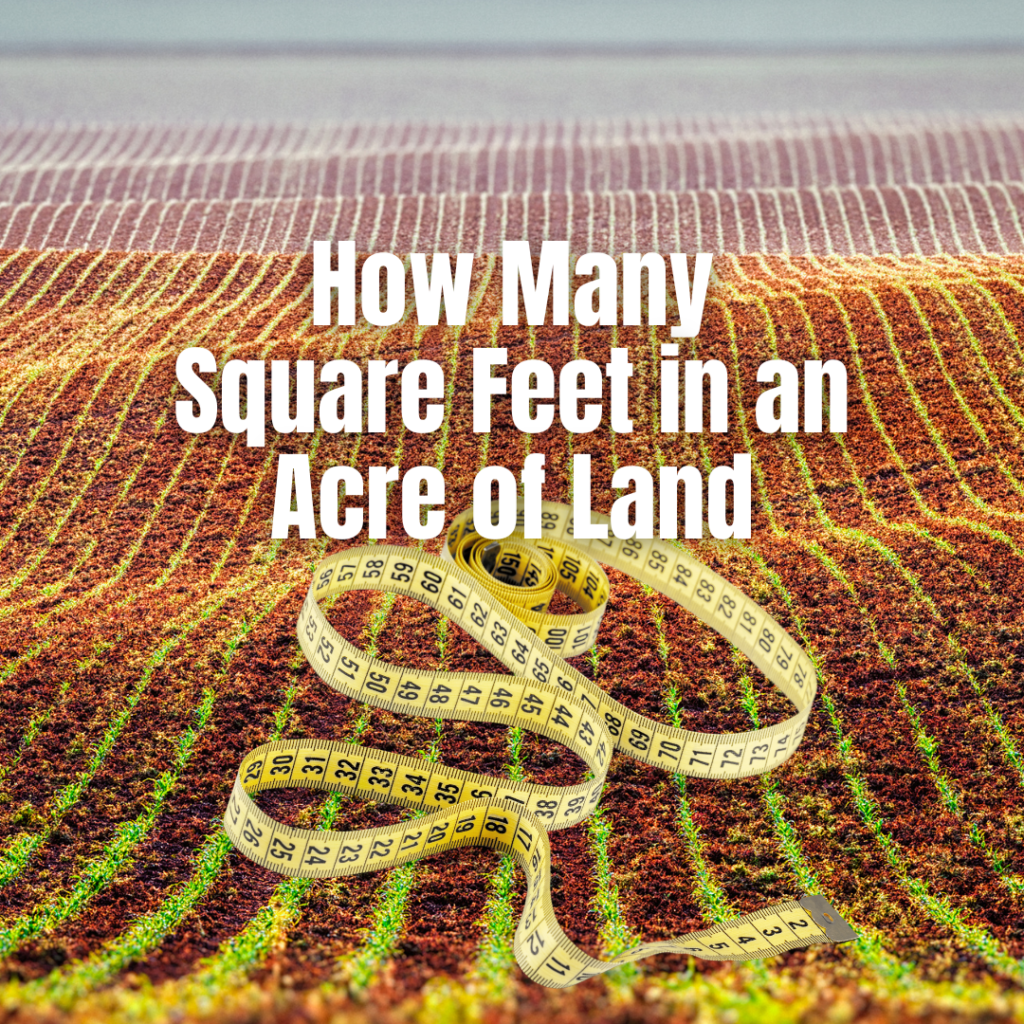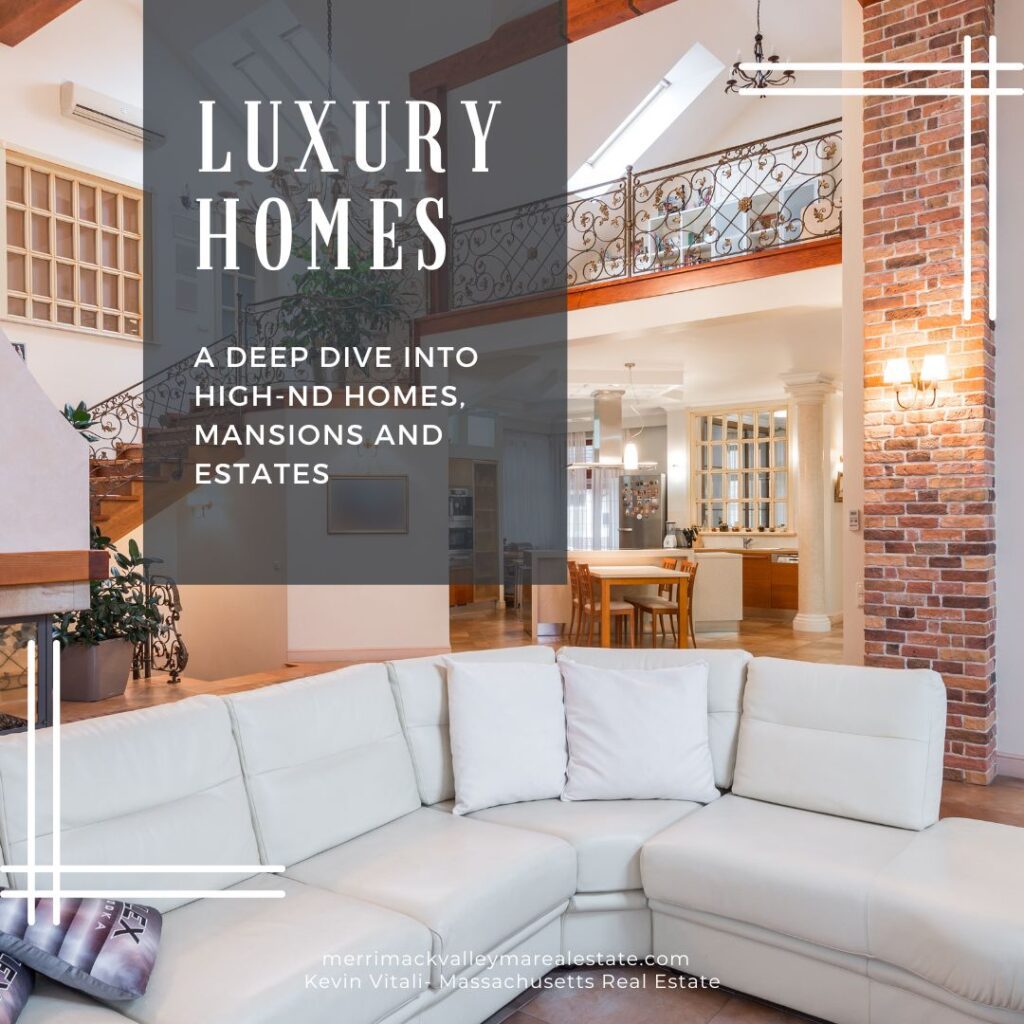 The term “bungalow” is envisioned by many as being a small, cottage like home. But a bungalow is rich in history and shaping America during the early 20th century.
The term “bungalow” is envisioned by many as being a small, cottage like home. But a bungalow is rich in history and shaping America during the early 20th century.
Many of the homes built in the late 1800s through the 1930s and can be found all across America. And certainly in my neck of the woods in the greater Boston area bungalows can be found alongside many other older house designs like colonials, capes, four squares and others.
The bungalow style home became a popular during the early 20th century, where the ornate Victorian’s were rejected for much simpler designs. A bungalow was thought to be simplistic yet artistic at the same time. The design itself maximized the efficiency of the space. They were easy to build using indigenous materials.
History of The Bungalow Home
The word bungalow came out of the Indian word Bungala and loosely translated means “belonging to Bengal”. The bungalow house design came from the need for English ambassadors requiring homes that were informal and easy to construct as they traveled to India. The design emerged in the mid-18th century while India was under English rule.
The home design made it to England, where it was refined even more before eventually reaching the United States. Architects and brothers Charles and Henry Greene made the bungalow-style home famous in Southern California around the turn of the century. Their designs were well received and quickly became popular in home magazines and mail-order house kits.
Most bungalows were built between 1890 and 1935. It was a wildly popular design that help house the growing middle class as the industrial revolution, changed the face of many cities and towns. It was considered a working class home, though there are many that were built to be considered luxury homes.
While today, we don’t see many new construction bungalows as they have been replaced with cheaper, more popular designs. A colonial would be a cheaper design to build and would give you more bang for your buck, and developers have opted to the basic colonial as their spec homes.
House plans for bungalows can certainly be found for homeowners that are looking to have custom construction done for a new home. It is still a popular design that is still beloved by many. Plans for bungalows can be quite simple to very elaborate depending on your tastes and budget.
What Is A Bungalow?
Bungalow homes can vary greatly in size and design and the materials used for construction. They can certainly span an income demographic from being a basic starter home to an elaborate luxury home.
But there are some common characteristics among bungalows. Lets take a look at those characteristics.
Small
The original bungalows were often small, cottage type homes. Not to say we haven’t seen big, elaborate bungalow designs to be made into luxury homes.
Balanced
While often not found to be symmetrical, bungalows show a great sense of balance and proportion. The proportions leaned more towards a square footprint than a rectangular footprint.
Low Profile
A bungalow’s profile is low and tight to the ground. It is usually one to one and a half stories. Often they started as one-story homes and were often expanded onto the attic.
Roofline
The roof is often a hip or gabled roof. The roof will have a signifcant overhang, often with the roof rafters showing. There are often dormers in the roof. And, if not, dormers make a great addition for expanding into the attic space.
Front Porch or Veranda
A bungalow home will have a covered front porch or veranda. It can be as simple as a covered landing or one that extends the entire front of the home and even wrap around the sides.
Columns
You will most likely see square or tapered columns holding up the roof on the porch or veranda.
High Ceilings
Often the bungalow’s interior will boast a high ceiling and many windows. High ceilings and lots of windows help to open up a smaller space.
Details and Built-ins
A bungalow style home will have simple details and lots of built-ins. Often you will see square columns on the inside of the home meant to separate living spaces in the interior.
Open Floor Plan
A bungalow will have an open floor plan and because they are on the smaller side the floor plan will be very space efficient.
Types of Bungalows
There are some common designs you will find among bungalow style homes.
Craftsmen
A craftsman bungalow is often signified by low-handling roofs with exposed decorative rafters. It will have a street-facing gabled roof, square columns with simple details, decorative windows, and a covered front porch. Original design elements included brown or green paint to blend with its natural surroundings.

Robert D. Hubble, CC BY-SA 4.0, via Wikimedia Commons
California Bungalow
There is not a big distinction between a Craftsman-style bungalow and a California-style bungalow. It will have a low overhang roof with exposed beams and a sizable porch or veranda. Materials are often the distinction between the two.
Often a California bungalow will be made of stucco, wood… either redwood horizontal planks or shingle, or a combination of both.
Modern Bungalow
A modern bungalow will have a more contemporary and look compared to the California and Craftsmen style brethren. You may see the introduction of circular columns and softened curved features.
Notice the arched window and entranceway in the example below.
Tudor Bungalow
A Tudor bungalow brings in some elements from a Tudor-style home. It will have a steeper roof, narrow windows, and half-timbering. The Tudor style is one of the easiest to identify.
You will generally find more ornate design in the interior and exterior detailing of a Tudor-style home.
Mission Bungalow
The Mission bungalow will take a traditional style and add a Spanish flair. Often made of stucco and having red clay roof shingles.
Chicago Bungalow
The Chicago-style bungalow grew up in Chicago to meet a distinct need. To fit on small urban lots, the Chicago style is more rectangular than square and is mainly made of brick.
It was mostly a low-hung-hipped roof with plenty of windows and usually had steps coming up the front from the street.
Prairie Bungalow
Prairie-style bungalows were designed by Prairie School architects out of Chicago. Frank Lloyd Wright is the most famous. The Prairie style put an emphasis on horizontal features, massive piers to hold the porch roof, lots of windows, and broad chimneys, and they were often designed from the inside out to incorporate the surroundings with the interior living space.
Materials were often stone, brick or stucco.
Ideas For Decorating A Bungalow-Style Home
Interior
Bungalows are meant to be small and cozy. You will also find lots of natural woodwork, open spaces and built-ins. Often, the emphasis was on the natural.
Think about bringing in large mirrors to help open up the smaller spaces. Working with mostly solid, neutral-colored pieces like rugs, furniture, and drapes will make the space feel larger. You can then add patterned or brighter colors to add accents.
Work with variations of whites and lighter, neutral paint colors. Lighter neutral colors will help accent the natural woodwork as well as make the space feel bigger.
Use natural materials when decorating to help emphasize the home. Natural fiber carpets, wicker baskets and linen are all natural materials to compliment the space.
When selecting decor pieces work with natural materials. Wood, stone, glass, etc… will help enhance the space.
Think about emphasizing the high ceilings with long flowing curtains and floor to ceiling bookshelves. By accenting the vertical space you will give a larger appearance.
Exterior
Improving your bungalows curb appeal will not only enhance your outdoor living space, it will increase your home’s value.
The design of a bungalow was meant to blend in with its natural surroundings.
Show off your home’s unique roofline and exterior details and blend it into your surroundings. Make sure to keep your landscaping proportionate, by design the bungalow was low and squat. Don’t over power it with tall trees and bushes.
Finally, the front walkway and front porch and a definite focal point. Show the front porch as a nice to have a morning cup of coffee or a place to relax after a long day.
Summary
As a Massachusetts Real Estate Agent, I love going to show bungalows. They are often little gems filled with surprises. And, they certainly can provide a unique living space to call home.
Many of the bungalows you find will be early 20th century and will be on the more affordable side on the resale market due to their smaller size, usually 900-1900 square feet. But a bungalow style home can certainly pack a punch as far as style design and uniqueness goes.
Other Real Estate Resources:
- Are you planning a home addition? Michelle Gibson provides advice on some considerations before you start your project. Of course, the first step is putting a budget together.
- Have you ever wanted to build a new home? Eric Jeanette covers some important point on financing your new construction home.
- The market has certainly been changing and may homeowners who have their house on the market may be thinking about reducing their price. Paul Sian provides some sage advice on when and how to reduce a price on a home.
- With house prices so high and rapidly appreciating, it leaves both the buyers and sellers wondering if a home will appraise. Bill Gassett explains the importance of an appraisal contingency in a contract.
What Is A Bungalow Style Home? is provided by Kevin Vitali of EXIT Realty. If you would like to sell or buy a home, give me a call at 978-360-0422 and let’s get the process started.
Real Estate Services in the following areas: Northeast Massachusetts, Merrimack Valley, North Shore and Metrowest. Including the following communities and the surrounding areas- Amesbury, Andover, Billerica, Burlington, Chelmsford, Dracut, Groveland, Haverhill, Lowell, Melrose, Merrimac, Methuen, Middleton, North Andover, North Reading, Reading, Stoneham, Tewksbury, Tyngsborough, Wakefield, Wilmington, Westford
There is not a big distinction between a Craftsman-style bungalow and a California-style bungalow. It will have a low overhang roof with exposed beams and a sizable porch or veranda. Materials are often the distinction between the two.
Often a California bungalow will be made of stucco, wood… either redwood horizontal planks or shingle, or a combination of both.
Modern Bungalow
A modern bungalow will have a more contemporary and look compared to the California and Craftsmen style brethren. You may see the introduction of circular columns and softened curved features.
Notice the arched window and entranceway in the example below.
Tudor Bungalow
A Tudor bungalow brings in some elements from a Tudor-style home. It will have a steeper roof, narrow windows, and half-timbering. The Tudor style is one of the easiest to identify.
You will generally find more ornate design in the interior and exterior detailing of a Tudor-style home.
Mission Bungalow
The Mission bungalow will take a traditional style and add a Spanish flair. Often made of stucco and having red clay roof shingles.
Chicago Bungalow
The Chicago-style bungalow grew up in Chicago to meet a distinct need. To fit on small urban lots, the Chicago style is more rectangular than square and is mainly made of brick.
It was mostly a low-hung-hipped roof with plenty of windows and usually had steps coming up the front from the street.
Prairie Bungalow
Prairie-style bungalows were designed by Prairie School architects out of Chicago. Frank Lloyd Wright is the most famous. The Prairie style put an emphasis on horizontal features, massive piers to hold the porch roof, lots of windows, and broad chimneys, and they were often designed from the inside out to incorporate the surroundings with the interior living space.
Materials were often stone, brick or stucco.
Ideas For Decorating A Bungalow-Style Home
Interior
Bungalows are meant to be small and cozy. You will also find lots of natural woodwork, open spaces and built-ins. Often, the emphasis was on the natural.
Think about bringing in large mirrors to help open up the smaller spaces. Working with mostly solid, neutral-colored pieces like rugs, furniture, and drapes will make the space feel larger. You can then add patterned or brighter colors to add accents.
Work with variations of whites and lighter, neutral paint colors. Lighter neutral colors will help accent the natural woodwork as well as make the space feel bigger.
Use natural materials when decorating to help emphasize the home. Natural fiber carpets, wicker baskets and linen are all natural materials to compliment the space.
When selecting decor pieces work with natural materials. Wood, stone, glass, etc… will help enhance the space.
Think about emphasizing the high ceilings with long flowing curtains and floor to ceiling bookshelves. By accenting the vertical space you will give a larger appearance.
Exterior
Improving your bungalows curb appeal will not only enhance your outdoor living space, it will increase your home’s value.
The design of a bungalow was meant to blend in with its natural surroundings.
Show off your home’s unique roofline and exterior details and blend it into your surroundings. Make sure to keep your landscaping proportionate, by design the bungalow was low and squat. Don’t over power it with tall trees and bushes.
Finally, the front walkway and front porch and a definite focal point. Show the front porch as a nice to have a morning cup of coffee or a place to relax after a long day.
Summary
As a Massachusetts Real Estate Agent, I love going to show bungalows. They are often little gems filled with surprises. And, they certainly can provide a unique living space to call home.
Many of the bungalows you find will be early 20th century and will be on the more affordable side on the resale market due to their smaller size, usually 900-1900 square feet. But a bungalow style home can certainly pack a punch as far as style design and uniqueness goes.
Other Real Estate Resources:
- Are you planning a home addition? Michelle Gibson provides advice on some considerations before you start your project. Of course, the first step is putting a budget together.
- Have you ever wanted to build a new home? Eric Jeanette covers some important point on financing your new construction home.
- The market has certainly been changing and may homeowners who have their house on the market may be thinking about reducing their price. Paul Sian provides some sage advice on when and how to reduce a price on a home.
- With house prices so high and rapidly appreciating, it leaves both the buyers and sellers wondering if a home will appraise. Bill Gassett explains the importance of an appraisal contingency in a contract.
What Is A Bungalow Style Home? is provided by Kevin Vitali of EXIT Realty. If you would like to sell or buy a home, give me a call at 978-360-0422 and let’s get the process started.
Real Estate Services in the following areas: Northeast Massachusetts, Merrimack Valley, North Shore and Metrowest. Including the following communities and the surrounding areas- Amesbury, Andover, Billerica, Burlington, Chelmsford, Dracut, Groveland, Haverhill, Lowell, Melrose, Merrimac, Methuen, Middleton, North Andover, North Reading, Reading, Stoneham, Tewksbury, Tyngsborough, Wakefield, Wilmington, Westford
 The term “bungalow” is envisioned by many as being a small, cottage like home. But a bungalow is rich in history and shaping America during the early 20th century.
The term “bungalow” is envisioned by many as being a small, cottage like home. But a bungalow is rich in history and shaping America during the early 20th century.
Many of the homes built in the late 1800s through the 1930s and can be found all across America. And certainly in my neck of the woods in the greater Boston area bungalows can be found alongside many other older house designs like colonials, capes, four squares and others.
The bungalow style home became a popular during the early 20th century, where the ornate Victorian’s were rejected for much simpler designs. A bungalow was thought to be simplistic yet artistic at the same time. The design itself maximized the efficiency of the space. They were easy to build using indigenous materials.
History of The Bungalow Home
The word bungalow came out of the Indian word Bungala and loosely translated means “belonging to Bengal”. The bungalow house design came from the need for English ambassadors requiring homes that were informal and easy to construct as they traveled to India. The design emerged in the mid-18th century while India was under English rule.
The home design made it to England, where it was refined even more before eventually reaching the United States. Architects and brothers Charles and Henry Greene made the bungalow-style home famous in Southern California around the turn of the century. Their designs were well received and quickly became popular in home magazines and mail-order house kits.
Most bungalows were built between 1890 and 1935. It was a wildly popular design that help house the growing middle class as the industrial revolution, changed the face of many cities and towns. It was considered a working class home, though there are many that were built to be considered luxury homes.
While today, we don’t see many new construction bungalows as they have been replaced with cheaper, more popular designs. A colonial would be a cheaper design to build and would give you more bang for your buck, and developers have opted to the basic colonial as their spec homes.
House plans for bungalows can certainly be found for homeowners that are looking to have custom construction done for a new home. It is still a popular design that is still beloved by many. Plans for bungalows can be quite simple to very elaborate depending on your tastes and budget.
What Is A Bungalow?
Bungalow homes can vary greatly in size and design and the materials used for construction. They can certainly span an income demographic from being a basic starter home to an elaborate luxury home.
But there are some common characteristics among bungalows. Lets take a look at those characteristics.
Small
The original bungalows were often small, cottage type homes. Not to say we haven’t seen big, elaborate bungalow designs to be made into luxury homes.
Balanced
While often not found to be symmetrical, bungalows show a great sense of balance and proportion. The proportions leaned more towards a square footprint than a rectangular footprint.
Low Profile
A bungalow’s profile is low and tight to the ground. It is usually one to one and a half stories. Often they started as one-story homes and were often expanded onto the attic.
Roofline
The roof is often a hip or gabled roof. The roof will have a signifcant overhang, often with the roof rafters showing. There are often dormers in the roof. And, if not, dormers make a great addition for expanding into the attic space.
Front Porch or Veranda
A bungalow home will have a covered front porch or veranda. It can be as simple as a covered landing or one that extends the entire front of the home and even wrap around the sides.
Columns
You will most likely see square or tapered columns holding up the roof on the porch or veranda.
High Ceilings
Often the bungalow’s interior will boast a high ceiling and many windows. High ceilings and lots of windows help to open up a smaller space.
Details and Built-ins
A bungalow style home will have simple details and lots of built-ins. Often you will see square columns on the inside of the home meant to separate living spaces in the interior.
Open Floor Plan
A bungalow will have an open floor plan and because they are on the smaller side the floor plan will be very space efficient.
Types of Bungalows
There are some common designs you will find among bungalow style homes.
Craftsmen
A craftsman bungalow is often signified by low-handling roofs with exposed decorative rafters. It will have a street-facing gabled roof, square columns with simple details, decorative windows, and a covered front porch. Original design elements included brown or green paint to blend with its natural surroundings.

Robert D. Hubble, CC BY-SA 4.0, via Wikimedia Commons
California Bungalow
There is not a big distinction between a Craftsman-style bungalow and a California-style bungalow. It will have a low overhang roof with exposed beams and a sizable porch or veranda. Materials are often the distinction between the two.
Often a California bungalow will be made of stucco, wood… either redwood horizontal planks or shingle, or a combination of both.
Modern Bungalow
A modern bungalow will have a more contemporary and look compared to the California and Craftsmen style brethren. You may see the introduction of circular columns and softened curved features.
Notice the arched window and entranceway in the example below.
Tudor Bungalow
A Tudor bungalow brings in some elements from a Tudor-style home. It will have a steeper roof, narrow windows, and half-timbering. The Tudor style is one of the easiest to identify.
You will generally find more ornate design in the interior and exterior detailing of a Tudor-style home.
Mission Bungalow
The Mission bungalow will take a traditional style and add a Spanish flair. Often made of stucco and having red clay roof shingles.
Chicago Bungalow
The Chicago-style bungalow grew up in Chicago to meet a distinct need. To fit on small urban lots, the Chicago style is more rectangular than square and is mainly made of brick.
It was mostly a low-hung-hipped roof with plenty of windows and usually had steps coming up the front from the street.
Prairie Bungalow
Prairie-style bungalows were designed by Prairie School architects out of Chicago. Frank Lloyd Wright is the most famous. The Prairie style put an emphasis on horizontal features, massive piers to hold the porch roof, lots of windows, and broad chimneys, and they were often designed from the inside out to incorporate the surroundings with the interior living space.
Materials were often stone, brick or stucco.
Ideas For Decorating A Bungalow-Style Home
Interior
Bungalows are meant to be small and cozy. You will also find lots of natural woodwork, open spaces and built-ins. Often, the emphasis was on the natural.
Think about bringing in large mirrors to help open up the smaller spaces. Working with mostly solid, neutral-colored pieces like rugs, furniture, and drapes will make the space feel larger. You can then add patterned or brighter colors to add accents.
Work with variations of whites and lighter, neutral paint colors. Lighter neutral colors will help accent the natural woodwork as well as make the space feel bigger.
Use natural materials when decorating to help emphasize the home. Natural fiber carpets, wicker baskets and linen are all natural materials to compliment the space.
When selecting decor pieces work with natural materials. Wood, stone, glass, etc… will help enhance the space.
Think about emphasizing the high ceilings with long flowing curtains and floor to ceiling bookshelves. By accenting the vertical space you will give a larger appearance.
Exterior
Improving your bungalows curb appeal will not only enhance your outdoor living space, it will increase your home’s value.
The design of a bungalow was meant to blend in with its natural surroundings.
Show off your home’s unique roofline and exterior details and blend it into your surroundings. Make sure to keep your landscaping proportionate, by design the bungalow was low and squat. Don’t over power it with tall trees and bushes.
Finally, the front walkway and front porch and a definite focal point. Show the front porch as a nice to have a morning cup of coffee or a place to relax after a long day.
Summary
As a Massachusetts Real Estate Agent, I love going to show bungalows. They are often little gems filled with surprises. And, they certainly can provide a unique living space to call home.
Many of the bungalows you find will be early 20th century and will be on the more affordable side on the resale market due to their smaller size, usually 900-1900 square feet. But a bungalow style home can certainly pack a punch as far as style design and uniqueness goes.
Other Real Estate Resources:
- Are you planning a home addition? Michelle Gibson provides advice on some considerations before you start your project. Of course, the first step is putting a budget together.
- Have you ever wanted to build a new home? Eric Jeanette covers some important point on financing your new construction home.
- The market has certainly been changing and may homeowners who have their house on the market may be thinking about reducing their price. Paul Sian provides some sage advice on when and how to reduce a price on a home.
- With house prices so high and rapidly appreciating, it leaves both the buyers and sellers wondering if a home will appraise. Bill Gassett explains the importance of an appraisal contingency in a contract.
What Is A Bungalow Style Home? is provided by Kevin Vitali of EXIT Realty. If you would like to sell or buy a home, give me a call at 978-360-0422 and let’s get the process started.
Real Estate Services in the following areas: Northeast Massachusetts, Merrimack Valley, North Shore and Metrowest. Including the following communities and the surrounding areas- Amesbury, Andover, Billerica, Burlington, Chelmsford, Dracut, Groveland, Haverhill, Lowell, Melrose, Merrimac, Methuen, Middleton, North Andover, North Reading, Reading, Stoneham, Tewksbury, Tyngsborough, Wakefield, Wilmington, Westford
There is not a big distinction between a Craftsman-style bungalow and a California-style bungalow. It will have a low overhang roof with exposed beams and a sizable porch or veranda. Materials are often the distinction between the two.
Often a California bungalow will be made of stucco, wood… either redwood horizontal planks or shingle, or a combination of both.
Modern Bungalow
A modern bungalow will have a more contemporary and look compared to the California and Craftsmen style brethren. You may see the introduction of circular columns and softened curved features.
Notice the arched window and entranceway in the example below.
Tudor Bungalow
A Tudor bungalow brings in some elements from a Tudor-style home. It will have a steeper roof, narrow windows, and half-timbering. The Tudor style is one of the easiest to identify.
You will generally find more ornate design in the interior and exterior detailing of a Tudor-style home.
Mission Bungalow
The Mission bungalow will take a traditional style and add a Spanish flair. Often made of stucco and having red clay roof shingles.
Chicago Bungalow
The Chicago-style bungalow grew up in Chicago to meet a distinct need. To fit on small urban lots, the Chicago style is more rectangular than square and is mainly made of brick.
It was mostly a low-hung-hipped roof with plenty of windows and usually had steps coming up the front from the street.
Prairie Bungalow
Prairie-style bungalows were designed by Prairie School architects out of Chicago. Frank Lloyd Wright is the most famous. The Prairie style put an emphasis on horizontal features, massive piers to hold the porch roof, lots of windows, and broad chimneys, and they were often designed from the inside out to incorporate the surroundings with the interior living space.
Materials were often stone, brick or stucco.
Ideas For Decorating A Bungalow-Style Home
Interior
Bungalows are meant to be small and cozy. You will also find lots of natural woodwork, open spaces and built-ins. Often, the emphasis was on the natural.
Think about bringing in large mirrors to help open up the smaller spaces. Working with mostly solid, neutral-colored pieces like rugs, furniture, and drapes will make the space feel larger. You can then add patterned or brighter colors to add accents.
Work with variations of whites and lighter, neutral paint colors. Lighter neutral colors will help accent the natural woodwork as well as make the space feel bigger.
Use natural materials when decorating to help emphasize the home. Natural fiber carpets, wicker baskets and linen are all natural materials to compliment the space.
When selecting decor pieces work with natural materials. Wood, stone, glass, etc… will help enhance the space.
Think about emphasizing the high ceilings with long flowing curtains and floor to ceiling bookshelves. By accenting the vertical space you will give a larger appearance.
Exterior
Improving your bungalows curb appeal will not only enhance your outdoor living space, it will increase your home’s value.
The design of a bungalow was meant to blend in with its natural surroundings.
Show off your home’s unique roofline and exterior details and blend it into your surroundings. Make sure to keep your landscaping proportionate, by design the bungalow was low and squat. Don’t over power it with tall trees and bushes.
Finally, the front walkway and front porch and a definite focal point. Show the front porch as a nice to have a morning cup of coffee or a place to relax after a long day.
Summary
As a Massachusetts Real Estate Agent, I love going to show bungalows. They are often little gems filled with surprises. And, they certainly can provide a unique living space to call home.
Many of the bungalows you find will be early 20th century and will be on the more affordable side on the resale market due to their smaller size, usually 900-1900 square feet. But a bungalow style home can certainly pack a punch as far as style design and uniqueness goes.
Other Real Estate Resources:
- Are you planning a home addition? Michelle Gibson provides advice on some considerations before you start your project. Of course, the first step is putting a budget together.
- Have you ever wanted to build a new home? Eric Jeanette covers some important point on financing your new construction home.
- The market has certainly been changing and may homeowners who have their house on the market may be thinking about reducing their price. Paul Sian provides some sage advice on when and how to reduce a price on a home.
- With house prices so high and rapidly appreciating, it leaves both the buyers and sellers wondering if a home will appraise. Bill Gassett explains the importance of an appraisal contingency in a contract.
What Is A Bungalow Style Home? is provided by Kevin Vitali of EXIT Realty. If you would like to sell or buy a home, give me a call at 978-360-0422 and let’s get the process started.
Real Estate Services in the following areas: Northeast Massachusetts, Merrimack Valley, North Shore and Metrowest. Including the following communities and the surrounding areas- Amesbury, Andover, Billerica, Burlington, Chelmsford, Dracut, Groveland, Haverhill, Lowell, Melrose, Merrimac, Methuen, Middleton, North Andover, North Reading, Reading, Stoneham, Tewksbury, Tyngsborough, Wakefield, Wilmington, Westford




